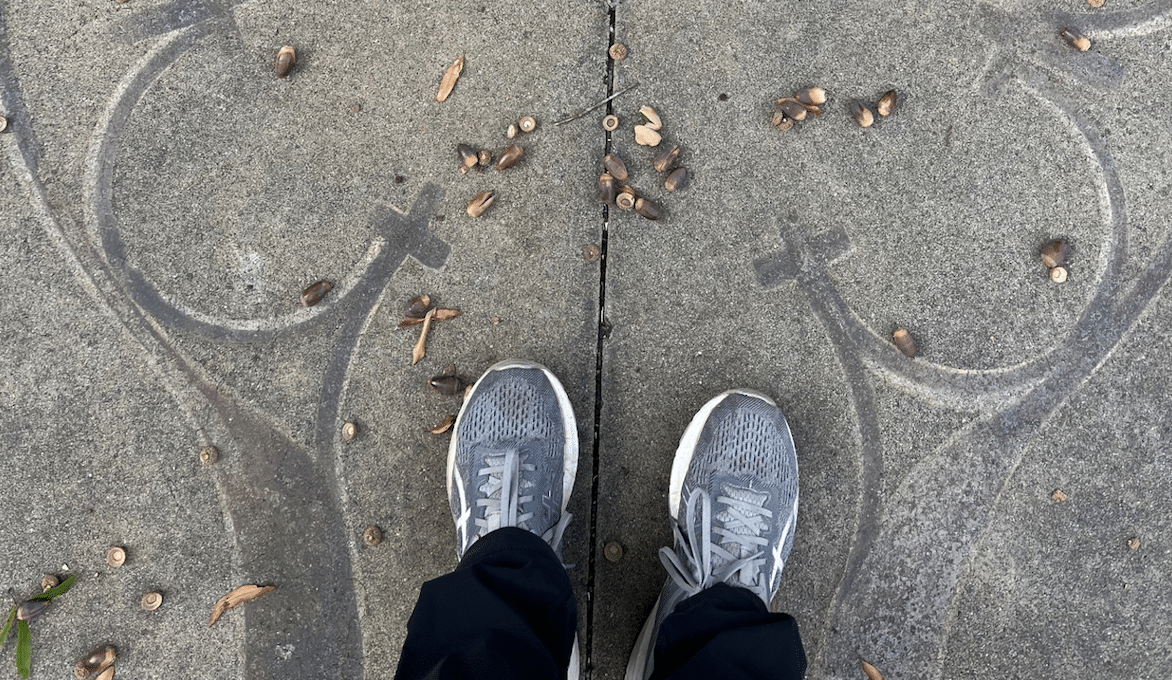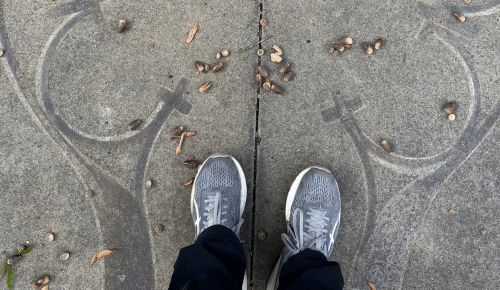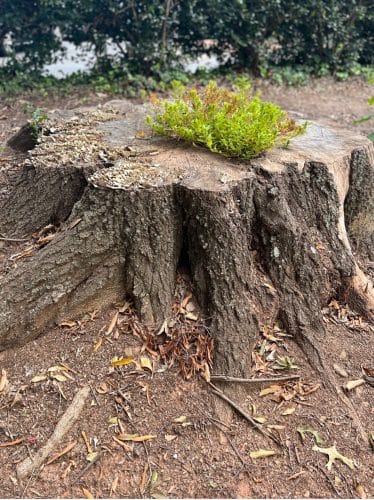
Somewhere deep in my memory still lingers the prologue of Geoffrey Chaucer’s Canterbury Tales, which my senior English teacher had us memorize over 25 years ago: “Whan that Aprille with his shoures soote, The droughte of March had perced to the roote.” While I do not remember every line (although surprisingly more than 17-year-old me would have believed), this one still sticks with me: “Thanne longen folk to goon on pilgrimages.” This specific line (which I definitely had to look up how to spell) has come to mind often as I have envied the stories of those who have gone on pilgrimages.

Sarah Blackwell
From hearing my divinity school classmates talk about their trip to the Holy Land together, to listening to Dr. Christena Cleveland describe her pilgrimages to the Black Madonnas in France on a podcast, to seeing pictures from those who have walked the Camino de Santiago in Spain, I have always relished these stories and dreamed of lacing up my own shoes and traveling by foot to the sacred spaces of my faith. The daily demands of this season of life have kept me from one of these larger journeys, but recently I realized there was nothing stopping me from being a pilgrim within my own hometown. Surely there were sacred sites here within my city that I could access by foot.
My family would tell you that my favorite thing to do on vacation in a new place is just to get out and walk–maybe with a destination but also in a wandering way. On the ground level, at an unhurried pace, I have always felt like I could truly appreciate so much more. Thus, it made sense to me that maybe I needed to do the same in the place that I live. Walking outside is also the way that I encounter God the best. Being free from distractions of my house and moving through nature allows me to connect on a spiritual level.
So, what would it look like to be a pilgrim in my own town? I began by searching for reflection gardens, labyrinths, open sanctuaries, monuments, and cemeteries within a walkable distance from each other and the heart of the Uptown area. With a general plan laid out to make sure I could make it back in time for carpool pickup (!), I made up a few ground rules for myself. I would only speak aloud if spoken to preserve a feeling of silence and solitude. Music and podcasts were a last resort and only if needed for motivation to make it through. Anything that stirred my curiosity along the way needed to be explored and not simply hurried past. I would seek to notice and understand. Finally, I would lean into the spirit of the command that God gave Jeremiah to seek the welfare of the city in which he lived and to pray to the Lord on its behalf (29:7). If I could not think of what to think about next, I would default to prayers for the people I encountered along the way.

Here are the seven sacred things I learned as a pilgrim for a day:
Find your rhythm. I found the first miles to be the hardest. As I set off from my first location, I quickly found my brain distracted and unable to set itself into any meaningful thought. I just knew I would be reaching for my headphones and podcasts to overcome my boredom by the end of the day-long journey. As I settled into a rhythm, though, I found a steadiness in my thoughts that felt like a true conversation with God, with times of talking and listening woven into the rhythm of my walking. I was more aware of my breath and attuned to how my body felt.
Embrace the unexpected. I started my journey at the memorial garden at a church near me where I knew one of the pastors. In my head, I had thought this would be a good place to pray at the beginning of my journey in silence and solitude. Little did I know that this spot was a favorite of the preschool children waiting to go into the church’s weekday school. As they played tag near me, I was, at first, a little irritated that my silent moments of reflection were constantly being interrupted by their shrieks and giggles. Of course, it did not take long for my heart to warm to their joy and comfort at being in this church home. I was even more appreciative of this moment when I reached my first stop along the way at the chapel on the grounds of a large former orphanage that borders what is now Uptown. As I stood on old farmlands, once teeming with children that had found a home in the care of the church orphanage, I was overcome by the silence and loneliness of a place that had once had such life. Now I was the only person around in the presence of that sacred space. Sometimes the juxtapositions help to highlight truths more clearly. For example, I had a poignant moment when I found a statue of St. Francis of Assisi, the great lover of nature, loomed over by the tall steel structures of the modern city. The beauty is often in the contrast.
Notice things better. Several times in my journey, I said to myself, “Has that always been there?” Without even a second glance, I had driven by a local Vietnam War Memorial, passed a little historic church right off the main road, and even dropped kids off for basketball games right next to the prettiest contemplation garden. By being on foot, I had time to take in my surroundings better and let myself linger in places that had always been more pass-through points. I also paid more attention to the people I encountered. I looked carefully for the Imago Dei in them as well as their unique expression and representation of that to the world.
Expect detours. While I had a good sense of the main roads I wanted to use, I tried to avoid staring at a map all the time. The exceptions to this came when I hit the inevitable road closure or construction detour. In these times of uncertainty, I had to go back to my road map and make sure that I was not veering too far of course. I kept coming back to that verse about God’s word as a lamp unto my path and looking for where the “light” seemed to draw me next.
Be aware of my privilege. As a white woman with means and education, I easily moved in and out of different contexts and environments without a second glance. I strolled through the tree-lined lanes of multi-million-dollar homes, lingered on church grounds, took pictures of interesting finds, and navigated my way through Uptown like any other white-collar worker. Never did I experience a question or look that signaled that I did not belong. Even simple things like access to bathrooms along the way was guaranteed by my ability to be a paying customer or my general air of belonging. I was struck by how a change of any of my identifiers might have signaled a threat to someone I encountered. Of course, I planned my route through places I believed to be largely safe for a woman walking alone based on the general foot and car traffic through the areas. This might have been a different story, though, if I had to make this journey at night. It was a good reminder that “safe” is a subjective word based on our identity.
Appreciate the little things. We often talk about it being the journey and not the destination that counts, and I found a walking pilgrimage in my hometown permitted me to lean into that. From discovering little free libraries to peaceful park benches to community gardens tucked into vacant lots to a well-timed Duck Donuts along my route, appreciating the small and simple joys was a highlight of the pilgrimage. It was fun to anticipate what might be just around the corner.
Look for the sacred anywhere and everywhere. I had plotted six different sacred sites to visit in my city over the course of eleven miles. I told myself, though, that I would stop and photograph all the sacred spaces that I encountered along the way. Many of these were not what I initially thought would be sacred spaces like sitting on a bench outside the heart center at a local hospital, resting in front of the center of justice at our county courthouse, discovering the stump of one of the ginormous trees that once lined the streets of our city teeming with new life, cutting through a bustling college campus, finding a sign supporting racial unity, looking at one of the inspirational murals that dot our buildings, or even noticing a park bench that someone had taken the time to decorate with ribbon. These were welcome reminders to stop and rest — to take in the holiness of the space.
In our country, we often think about pilgrims in the way that our Thanksgiving traditions teach us — that it is all about the destination. The point for Americans is often where we get to. In many ways, the pilgrims of Plymouth Rock may have been more of religious or economic refugees as pilgrims on a journey seeking the divine. We often skip over their actual journey in favor of celebrating their landing. As I reflect on my pilgrimage, though, I like the pilgrims of the old Canterbury Tales and the truths they told on the journey. In that tale, we do not even know if they make it to Canterbury. The real story is the people and lessons encountered along the way. So, tie up those shoes, get walking, and maybe you, too, can become a different kind of pilgrim this fall.
Sarah Blackwell is a contributing writer for Word&Way and a 2020 Graduate of the Gardner-Webb School of Divinity. She currently teaches in the religion department at Wingate University in Wingate, NC. She lives several miles from “Uptown” Charlotte, which is the only way that true Charlotteans refer to the “big buildings” in the city center. Follow her writings at proximitytolove.org

Bench in Romare Bearden Park, Charlotte, NC

New Life in Old Oak Stump, Myers Park, Charlotte, NC

Labyrinth’s Center at Avondale Presbyterian Church, Charlotte, NC

St. Patrick’s Catholic School Garden, Charlotte, NC

Lighted Construction Path, Charlotte, NC

St. Ignatius of Loyola at St. Peter’s Catholic Church, Charlotte, NC

Settler’s Cemetery with First Presbyterian Church and Uptown Skyline, Charlotte, NC

St. Peter’s Episcopal Church, Charlotte NC

St. Francis of Assisi, St. Peter’s Episcopal Garden, Charlotte, NC

Mural on 7th Street, Uptown Charlotte, NC

Little Sugar Creek Greenway, Charlotte, NC

St. Mary’s Chapel on the former grounds of the Thompson Orphan Farm, Charlotte, NC

Views of Uptown Charlotte, NC






